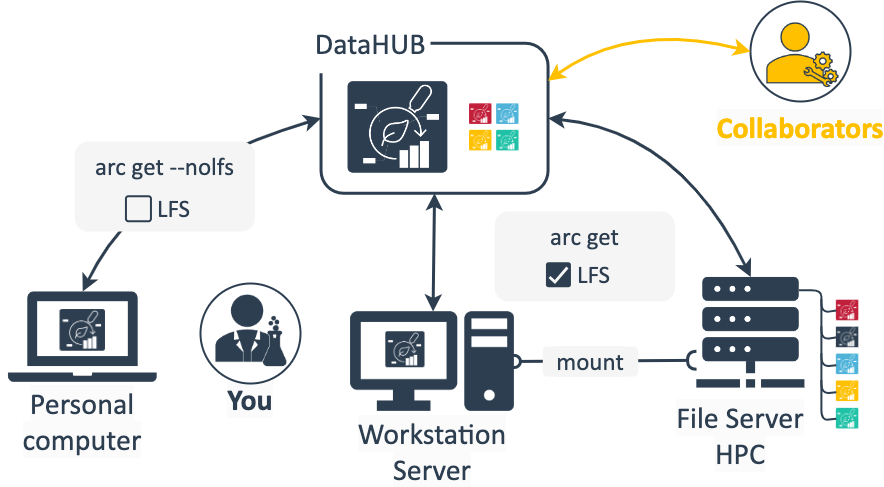Home
Fundamentals
Research Data Management
FAIR Data Principles
Metadata
Ontologies
Data Sharing
Data Publications
Data Management Plan
Version Control & Git
Public Data Repositories
Persistent Identifiers
Electronic Lab Notebooks (ELN)
DataPLANT Implementations
Annotated Research Context
ARC specification
ARC Commander
Swate
MetadataQuiz
DataHUB
DataPLAN
Ontology Service Landscape
Manuals
ARC Commander
Setup
Git Installation
ARC Commander Installation
Windows
MacOS
Linux
ARC Commander DataHUB Access
Before we start
Central Functions
Initialize
Clone
Connect
Synchronize
Configure
Branch
ISA Metadata Functions
ISA Metadata
Investigation
Study
Assay
Update
Export
ARCitect
Installation - Windows
Installation - macOS
Installation - Linux
QuickStart
QuickStart - Videos
ARCmanager
What is the ARCmanager?
Connect to your DataHUB
View your ARCs
Create new ARCs
Add new studies and assays
Upload files
Add metadata to your ARCs
Swate
QuickStart
QuickStart - Videos
Annotation tables
Building blocks
Building Block Types
Adding a Building Block
Filling cells with ontology terms
Advanced Term Search
File Picker
Templates
Contribute Templates
ISA-JSON
DataHUB
Overview
User Settings
Generate a Personal Access Token (PAT)
Projects Panel
ARC Panel
Forks
Working with files
ARC Settings
ARC Wiki
Groups Panel
Create a new user group
CQC Pipelines & validation
Find and use ARC validation packages
Data publications
Passing Continuous Quality Control
Submitting ARCs with ARChigator
Track publication status
Use your DOIs
Guides
ARC User Journey
Create your ARC
ARCitect QuickStart
ARCitect QuickStart - Videos
ARC Commander QuickStart
ARC Commander QuickStart (Experts)
Annotate Data in your ARC
Annotation Principles
ISA File Types
Best Practices For Data Annotation
Swate QuickStart
Swate QuickStart - Videos
Swate Walk-through
Share your ARC
Register at the DataHUB
DataPLANT account
Invite collaborators to your ARC
Sharing ARCs via the DataHUB
Adding a LICENSE to your ARC
Work with your ARC
Using ARCs with Galaxy
Computational Workflows
CWL Introduction
CWL runner installation
CWL Examples
CWL Metadata
Recommended ARC practices
Syncing recommendation
Keep files from syncing to the DataHUB
Managing ARCs across locations
Working with large data files
Adding external data to the ARC
ARCs in Enabling Platforms
Publication to ARC
Working with branches
Troubleshooting
Git Troubleshooting & Tips
Contribute
Swate Templates
Knowledge Base
Teaching Materials
Events 2023
Nov: CEPLAS PhD Module
Oct: CSCS CEPLAS Start Your ARC
Sept: MibiNet CEPLAS Start Your ARC
July: RPTU Summer School on RDM
July: Data Steward Circle
May: CEPLAS Start Your ARC Series
Start Your ARC Series - Videos
Events 2024
TRR175 Becoming FAIR
CEPLAS ARC Trainings – Spring 2024
MibiNet CEPLAS DataPLANT Tool-Workshops
TRR175 Tutzing Retreat
Frequently Asked Questions
last updated at 2024-07-17
About this guide
This guide presents recommendations on managing one ARC on different devices and locations
Before we can start
☑️ You have a DataPLANT account
Where do I store my ARC?
As with projects and data shared via cloud services or other platforms, ARCs do not exist in just one location. Depending on your preferences and current use-case you can choose one of various starting points: you can create your ARC in different locations (e.g. personal computer, shared server or directly in the DataHUB) and to do so you can use different tools (e.g. ARC Commander, ARCitect, by hand).

A typical scenario could look like this: You create your ARC on you personal computer, add structure with studies and assays as you see fit and upload the ARC to the DataHUB to have a save copy and be able to share it with collaboration partners. You acquire some large dataset, e.g. from an OMICS assay, which you do not want to store or analyze on your computer. Instead you keep this on a larger workstation in the lab or a server or high performance computing (HPC) cluster, where you would also run data analysis workflows. With the DataHUB as the meeting point, you can keep your ARC in sync across these locations. Simply download the ARC from the DataHUB to your server, add the dataset from there and synchronize it back to the DataHUB. You could consider your ARC stored in the DataHUB as the "ground truth" – even if you delete the ARCs on your local computer or the server, it will still be available in the DataHUB including the change history from those source locations.
Keep your ARC in sync
A few things are important when maintaining ARCs in multiple locations:
- Try to keep your ARC in sync via the DataHUB
- Make sure to sync large files properly
As with any cloud service, when a single file is edited from multiple locations, you can run into merge conflicts. To avoid these, make sure to regularly sync your ARC with the DataHUB and from there sync with your (other) locations before adding or editing data.
In order to have the large files only where you need them and not where you do not (e.g. your personal computer), the ARC and DataHUB implement the LFS (Large file storage) system. The ARCitect and ARC commander provide options to properly handle LFS-tagged files.

DataPLANT Support
Besides these technical solutions, DataPLANT supports you with community-engaged data stewardship. For further assistance, feel free to reach out via our
helpdesk
or by contacting us
directly
.

